In the late 1990s, the prolific small-boat designer Iain Oughtred worked with his friend Brice Avery to design a trailerable coastal cruiser. With inspiration drawn from canoe yawls of yore, the resulting craft would be known as Eun Mara. A gaff-rigged yawl, it has a 19′ 9″ length on deck, a 6′ 8″ beam, and draws 1′ 5″ bilgeboards up and 3′ 4″ with them down. The twin bilgeboard trunks are integrated into the interior furniture, leaving the spartan but spacious cabin more open than it would otherwise be with a traditional centerboard trunk dividing the space.
The plans include a centerboard option paired with an inboard rudder and self-draining cockpit as well as a sloop rig. The 11 pages of drawings come with a table of offsets for lofting the boat but also include full-sized patterns for the molds with the plank lands drawn in. The hull is glued-lapstrake construction using 3⁄8″ marine-plywood planks and decking with dimensional lumber used for the backbone, keel, and a pair of laminated frames to help support the deck-stepped mainmast. There are approximately 400 lbs of lead in the keel, and the two bilgeboards are 3⁄4″-thick steel plate, each weighing about 100 lbs, for roughly 600 lbs of ballast.
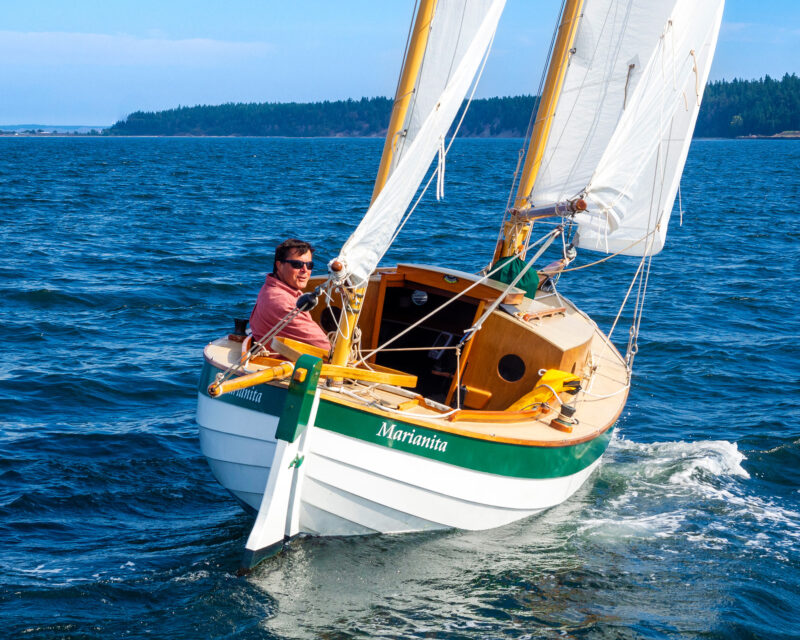 Dieter Loibner
Dieter LoibnerThe plans offer an option for an inboard rudder with a tiller forward of the mizzenmast, but for the outboard rudder, which is also offered by Oughtred, a split tiller that loops around the mizzenmast is required.
Auxiliary propulsion is provided by an outboard located in a small well built into the aft end of the cockpit/afterdeck area and offset to one side of the mizzenmast. Most owners have found 6 hp to be adequate for the roughly 2,500-lb boat. The mainmast of the gaff rig is stepped on deck in a tabernacle. The standing rigging is a forestay with upper and lower shrouds. The unstayed gaff-rigged mizzen is stepped through the aft deck to the sternpost. A small jib flies from the bowsprit; whether it hanks to the forestay or uses a furler is left to the builder. The bowsprit and boomkin each add about 4′ to the overall length and the mizzen boom extends a couple of feet past the boomkin, so you’ll need about 30′ of dock space to moor your 19′ 9″ LOD Eun Mara.
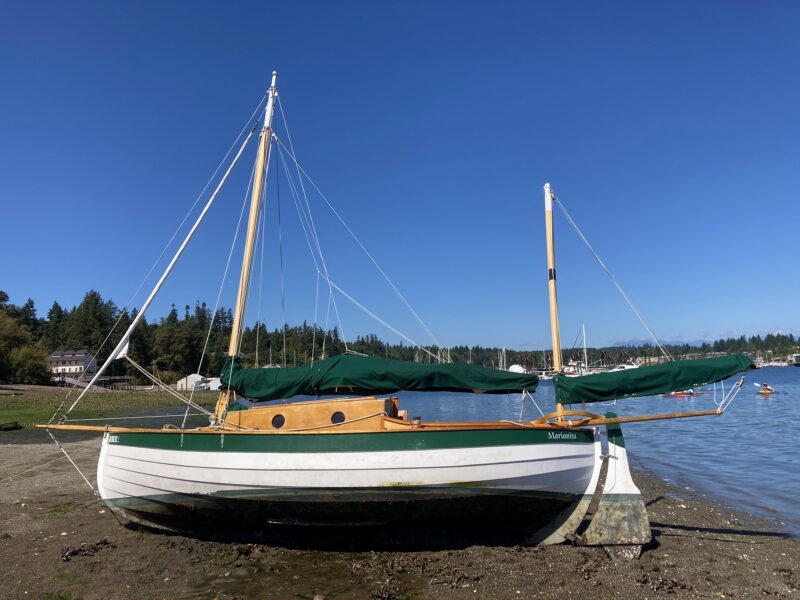 Steve Borgstrom
Steve BorgstromThe Eun Mara can be beached upright by partially lowering the bilge keels, but if I need to access the bottom, I can retract the bilge keels, and let the boat heel as it dries out. The outboard rudder is designed with a drop-down blade, here seen lowered, to get a purchase in the water below the keel. The line seen hanging against the side of the rudder is for retracting the blade.
The boat was intended to be a “trailerable coastal cruiser,” and while the Eun Mara is indeed trailerable, setting up and striking the yawl rig rules out casual daysailing. It’s more likely to be used as a long-weekend or week-long cruising boat. My Eun Mara, MARIANITA, lives in the water, and I only need about 10 minutes to put the motor in the well and stow the sail covers. But getting her from road-ready to launched is about a two-hour process. The deck-stepped mainmast pivots in a tabernacle; a block-and-tackle running from the bowsprit to the forestay is adequate to lift the mast into place, and I’ve raised and lowered the mast both on the water and on the trailer by myself, but it is certainly easier with extra hands. The unstayed mizzenmast simply slides into a hole in the after deck. With the companionway open, all of the spars, except mainmast, fit in the boat. I lace the sails on, but hoops or robands might be faster for somebody who moves the boat on and off a trailer more frequently. With its shoal draft, the boat sits low enough on the trailer so that it can be launched from most boat ramps; a crane isn’t needed.
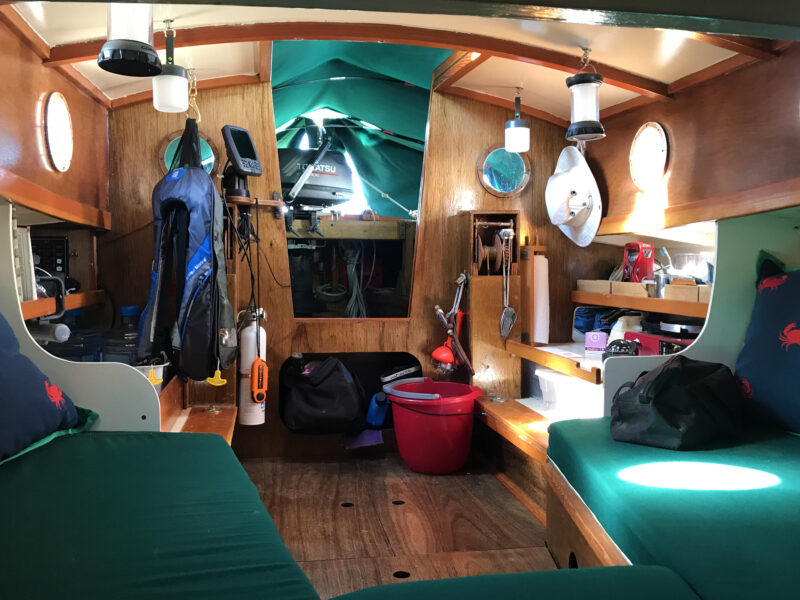 Steve Borgstrom
Steve BorgstromFor a boat that has a hull only 19′ 9″ long, the Eun Mara’s cabin is surprisingly spacious. The bilge keels are housed in trunks that support the V berths, their lifting winches are housed in boxes built on the bulkhead either side of the companionway.
On the water, the double-ended cruiser has an old-school feel with a cockpit that is on the small side by modern standards, but with the non-self-bailing configuration, is comfortably deep: you sit in the boat, not on it, and for the singlehander everything you need is within reach. Benches on either side can be configured as spacious lockers, although too much weight aft will drop her stern quickly.
An outboard rudder demands a tiller that finds its way around the mizzenmast; the specified single-sided stick bent around the mast, or a hoop will work. Either is an opportunity to fire up the steambox and bend some wood. With Iain Oughtred’s blessing, I played with a Norwegian push-pull setup, but the boat is a little too big for this style of tiller. As designed, the rudder is a bit of a barn door with a drag-inducing 3″ squared-off trailing edge. I have replaced it with a more up-to-date NACA (National Advisory Committee for Aeronautics) foil, and it has proven worth the effort. I also gave the bilgeboards, which are square-edged in the plans, as much shape as their 3⁄4″ thickness allowed by adapting the Pollock pattern Michael Storer uses on his Oz Goose.
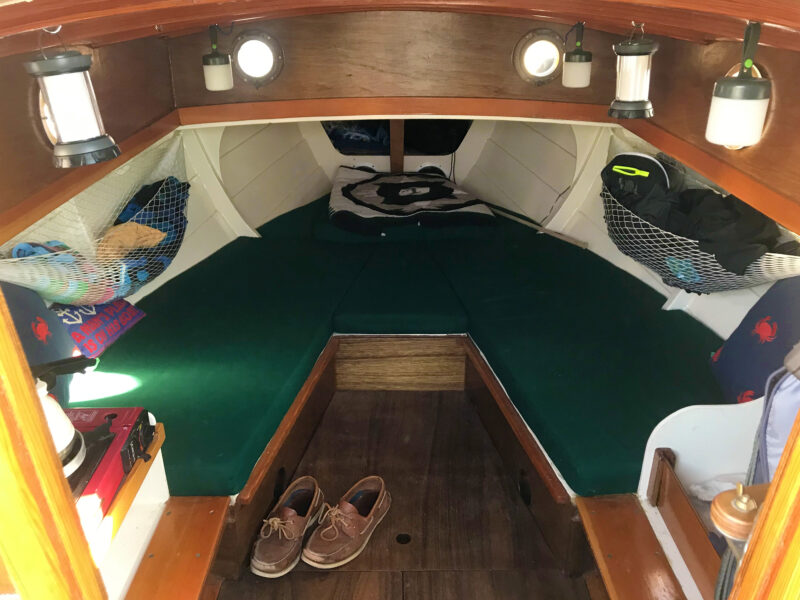 Steve Borgstrom
Steve BorgstromUp forward, the deck-stepped mainmast is supported by an oversized deckbeam so there is no compression post taking up room in the cabin. The V-berth can be converted to a double by lifting the cabin sole and setting it onto the support ledges on either side of the V.
Down below is a spacious cabin with 7′ V-berths and comfortable sitting headroom. There is space for a galley on one side and a navigation/library/ship’s stores area on the other. The bilgeboard trunks are beneath the berths and, with the deck-stepped mast supported by a beam instead of a compression post, the cabin feels very open. The center section of the cabin sole can be fitted between the V-berths to create a queen-sized sleeping platform. The cabin is a comfortable place to sleep, though it is worth noting that the bilgeboard trunk caps are 1″ above the waterline and roughly 22″ outboard of the centerline: when the boat rolls port and starboard, water sometimes slaps the bottom of the trunk lids. Keeping the bow into the waves will help quiet things down. To line up with the waves I either use the mizzen as a riding sail or set a stern anchor.
The plywood berth tops are epoxy-filleted to the hull, creating a stiff structure that can have any number of hatches cut-in for shallow storage options or positive flotation. There is a small watertight compartment forward and another aft, which the designer notes in the plans might be just enough to keep the boat afloat but not much more. There is no provision for a head; I use a folding toilet seat with WAG bags and stash the used bags in a sealed container in one of the cockpit lockers.
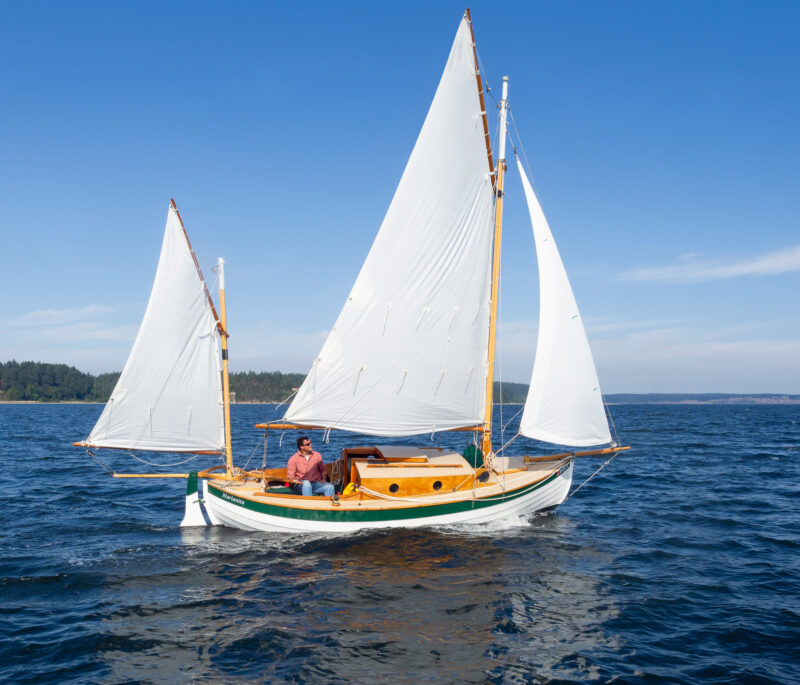 Dieter Loibner
Dieter LoibnerThe Eun Mara design was influenced by the popular canoe yawls of the late 19th and early 20th centuries. The gaff-yawl rig offers versatility in a wide range of wind strengths, and when I’m singlehanding, the mizzen acts as a useful crewmember, holding the bow close to the wind as I raise and set the main and jib.
I sewed the sails from a Sailrite kit. When I’m ready to get sailing, I hoist the mizzen and sheet it in hard; the boat will lay about 20 to 30 degrees off the wind while I go forward to get the main up, then it’s back to the cockpit, raise the jib, and I’m off. In high-wind conditions it’ll sail reasonably well under just the jib and mizzen, coming close to hitting hull speed without a lot of drama. As a gaffer, it doesn’t point particularly well, but ease the sheets a bit and it’ll take off. Beamy and lightweight, the Eun Mara suffers when going to windward in choppy conditions and pounding through the waves really slows it down. The flatter the water, the better it sails. I’ve had some ripping sailing in a harbor where there isn’t enough fetch for much chop to develop. The mizzen is big enough to balance the helm. Easing it while tacking helps prevent getting caught in irons. To speed coming about, I backwind the jib a touch. Under power, I can cruise along with the fuel-sipping 6-hp outboard at 4 knots all day. The motor can take the boat over 5 knots but with a lot more sound and fury. Retracting the bilgeboards when motoring is good for at least 1⁄2 knot.
Overall, the Eun Mara meets the design brief of a comfortable, capable, coastal cruiser. The foredeck stays dry, and the cockpit does a wonderful job of creating a safe, snug sailing area. Down below is a fine place to spend the night or take shelter from the weather with plenty of room for a captain, first mate, and maybe a small child. But where the boat excels is as a singlehanded cruiser. There’s plenty of room for stores, and with a simple, flexible sail plan the Eun Mara takes care of the crew. The little mizzen sail is like an extra crew member when you most need one, holding the boat steady while hoisting sail, putting in a reef, or dealing with the anchor. I built MARIANITA over the course of two-and-a-half years in a converted two-car garage. The plans are excellent but this is a big project and having some prior experience in building smaller boats will help.![]()
Steve Borgstrom, a self-described serial builder, lives on Bainbridge Island in Washington State. With a 1,500-sq-ft shop and 1,500-sq-ft house he lives a balanced life, supporting his boatbuilding habit by working as a firefighter in a nearby city. Not content with the half-dozen boats he has built so far, he’s accumulating plans and materials for the next three.
Eun Mara Particulars
LOD: 19′ 9″
LWL: 18′ 1″
Beam: 6′ 8″
Draft: 1′ 5″/3′4″
Sail area: 240 sq ft
Weight: 1,600 lbs
Displacement: 2,300 lbs
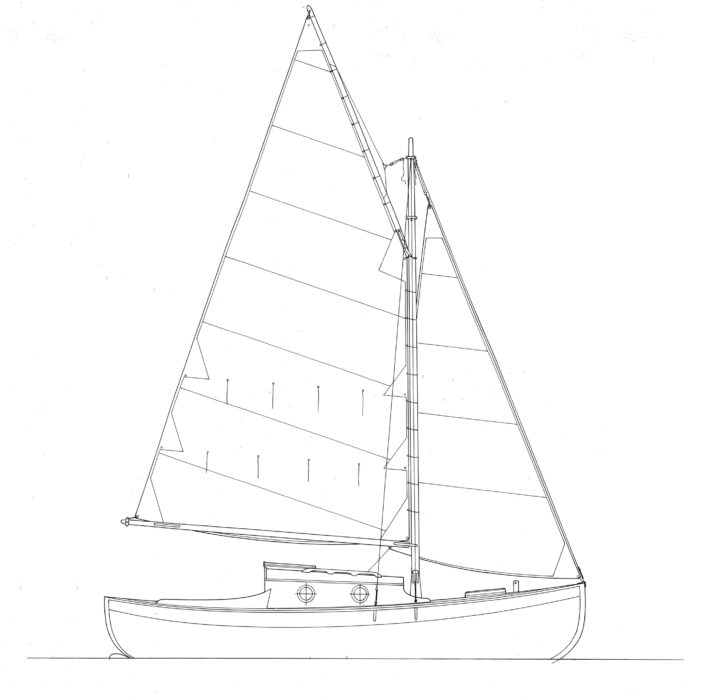 Eun Mara plans and kit are available from Oughtred Boats.
Eun Mara plans and kit are available from Oughtred Boats.
Is there a boat you’d like to know more about? Have you built one that you think other Small Boats readers would enjoy? Please email us your suggestions.
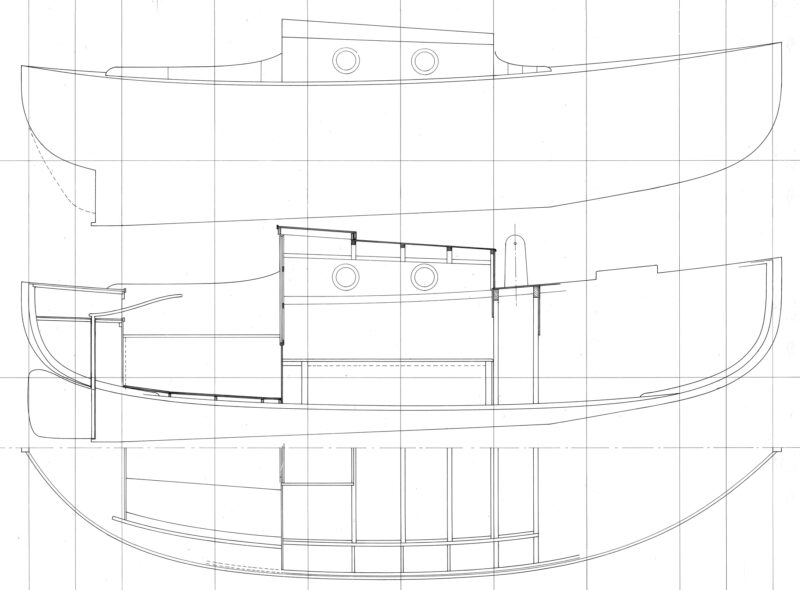
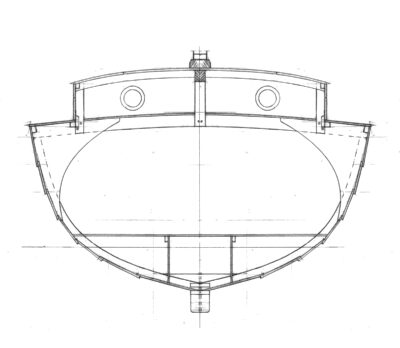

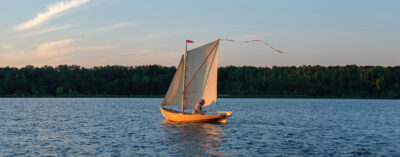
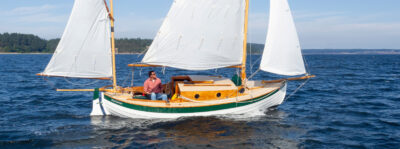
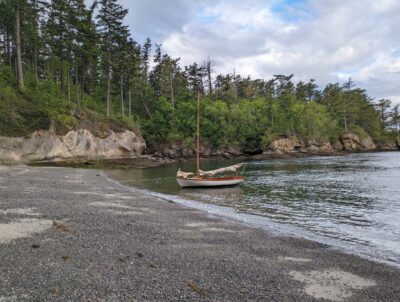


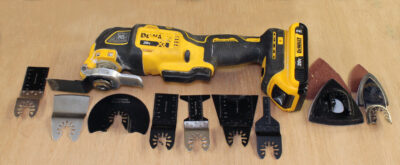
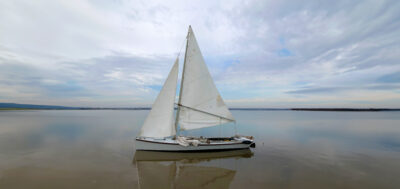
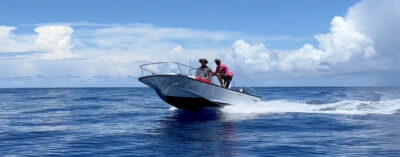
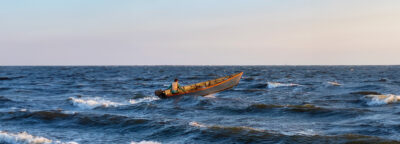
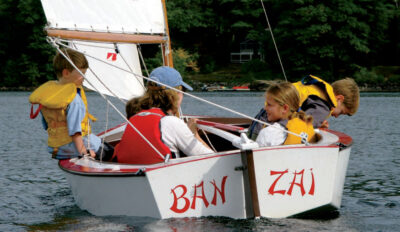
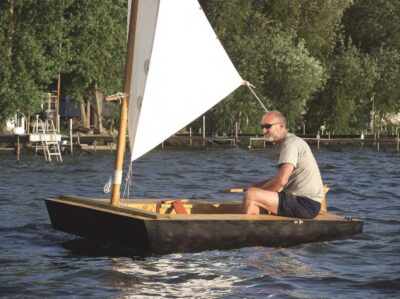
I’ve seen MARIANITA several times. Wonderful boat beautifully executed! Thanks for the story on her build and performance, Steve!
Thanks, Steve. Great article and description. Like Alex, Alison and I have admired “Marianita” several times. We enjoyed our Eun Mara too. A pity we had to sell her but she has a good owner now, who has renamed her “Skye”. We did some excellent cruising trips with her, one of six weeks, one of a month and others shorter, over five years. We kept her at home on her trailer, so as you say, she was a cruising boat, not a boat for just a sunny afternoon.
By the way, “Eun Mara” or “Eun na Mara” (Iain wrote it both ways) is Scottish Gaelic for “bird of the sea” (= sea-bird).
Ian
A beautiful boat. What would be the cost to build or buy today?
Fredericton, NB
Canada
Great article Steve. You will be pleased to know that the prototype is still sailing around on the west coast of Scotland. Right now bobbing about on her mooring at the end of the garden.
Best wishes, Brice Avery.
Both bilge keels are used continuously upwind? Is there any performance tinkering to be had by adjusting one or the other or both, or are they pretty much set and forget (at least until they start tinking along the rocks?)
Beautiful, how long did it take to build her? I really like the sail plan and the use of bilgeboards.
Steve, thanks for your story of Marianita. A long time ago I’ve also started to build an Eun Mara “notedop” (means nutshel). I’ve been sailing on a lot other boat and my boat didn got the intentions she needed. I was being told by some of my friends (not asking but demanding) to finish the job. This article, your story is also a right push.
next job bilgeboards and placing the keel. Thanks, Edwin (Netherlands)